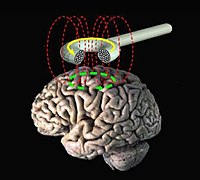
Photo from wikipedia
BACKGROUND Chronic orofacial pain (COP) patients often perceive the painful face area as "swollen" without clinical signs; such self-reported illusions of the face are termed perceptual distortion (PD). The pathophysiological… Click to show full abstract
BACKGROUND Chronic orofacial pain (COP) patients often perceive the painful face area as "swollen" without clinical signs; such self-reported illusions of the face are termed perceptual distortion (PD). The pathophysiological mechanisms underlying PD remain elusive. OBJECTIVE To test the neuromodulatory effect of repetitive transcranial magnetic stimulation (rTMS) on PD in healthy individuals, to gain insight into the cortical mechanisms underlying PD. METHODS PD was induced experimentally by injections of local anesthetic (LA) around the infraorbital nerve and measured as perceived size changes of the affected area. Participants were randomly allocated to inhibitory rTMS (n = 26) or sham rTMS (n = 26) group. The participants rated PD at baseline, 6 min after LA, immediately, 20 and 40 min after rTMS. The rTMS (inhibitory and sham) was applied to face (lip) representation area of primary somatosensory cortex (SI) as an intervention at 10 min after the LA, when the magnitude of PD is large. As inhibitory rTMS, continuous theta-burst stimulation paradigm (50 Hz) for 40s was employed to inhibit cortical activity. RESULTS We demonstrated a significant decrease in the magnitude of PD immediately and 20 min after the application of inhibitory rTMS compared with sham rTMS (P < 0.006). In two control experiments, we also showed that peripheral muscle stimulation and stimulation of a cortical region other than the lip representation area had no effect on the magnitude of the PD. CONCLUSIONS Inhibitory rTMS applied to a somatotopical-relevant cortical region modulates PD of the face in healthy individuals and could potentially have therapeutic implications for COP patients.
Journal Title: Brain Stimulation
Year Published: 2020
Link to full text (if available)
Share on Social Media: Sign Up to like & get
recommendations!